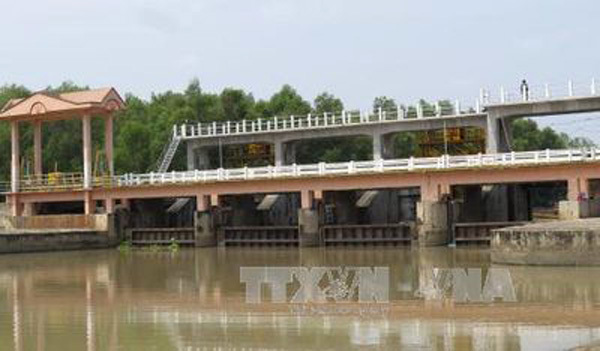 |
|
A resident in Ben Tre Province in southern Vietnam prepares a tank to store fresh water before the rainy season arrives.
|
Ky Quang Vinh, former head of the Climate Change Coordination Office in Can Tho City, told the Vietnam News Agency that over the last two weeks, water levels on the Mekong River have risen just a little and are equal to those in 2019 when they hit record lows.
He noted water levels recorded on the Mekong River at Cambodia’s Stung Treng and Kratie hydrological monitoring stations will predict the scale of the flood season in Vietnam.
According to the Mekong River Commission, water levels recorded on August 17 were 5.82 metres at the Stung Treng station and 14.11 metres at Kratie, only 0.5 metres and 1.59 metres higher than in 2019, respectively.
The water levels at the two Cambodian stations are still lower and only slightly higher than in 2016 and 2019 respectively, when severe drought and saltwater intrusion hit the delta.
In downstream areas of Vietnam, water levels of 1.55 metres were recorded at Tan Chau station on the Tien River, a major tributary of the Mekong River, on August 17; twice as high as those last year (0.83 metres) and close to levels in 2016 (1.61 metres). Levels measured at the Chau Doc station on the Hau River, another tributary, were 1.57 metres, or 0.08 metres higher than in 2016.
These figures indicate a lack of conditions for a flood season, which is important for local agriculture and aquaculture, Vinh said.
Nguyen Huu Thien, an independent expert on the Mekong Delta’s ecology, noted that rain in the Vientiane and Pakse regions of Laos will decide the scale of flooding in the delta.
Based on data recorded so far, he said this year’s floods will come later than average and are unlikely in August. Whether they come in September or later will depend on if the La Nina weather pattern, which triggers a lot of rain, is in place.
Smaller floods will lead to serious water shortages and saline encroachment in the dry season, and if water levels remain low through mid-October, these two phenomena may happen in March next year in coastal localities, according to Thien.
The Mekong River basin is currently facing the El Nino-Southern Oscillation (ENSO) weather pattern, which is neither El Nino nor La Nina, he added.
The US Climate Prediction Centre has forecast that there is a 55 per cent chance of La Nina taking shape in September, Thien said, and he believes drought and saltwater intrusion in early 2021 will not be as severe as in the 2020 dry season. VNS

Severe drought, saline intrusion can be predicted months in advance: expert
Nguyen Huu Thien, an independent expert on the Mekong Delta, said he warned of severe drought and saline intrusion in mid-2019 after observing the flood season and the salty-fresh water boundary of the river.

Mekong Delta provinces adapt to drought, saltwater intrusion
Provinces in the Mekong Delta are taking prompt actions to help local residents adapt to drought and saltwater intrusion during the dry season.